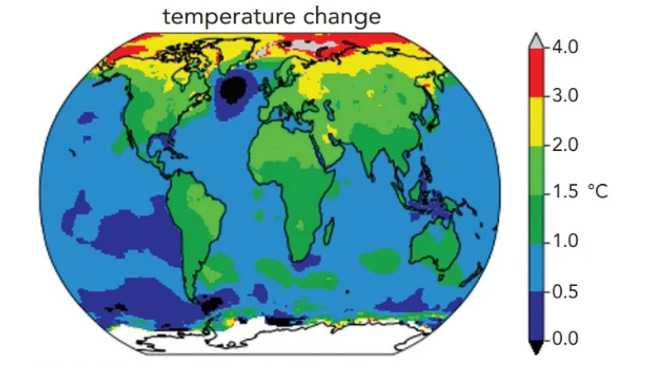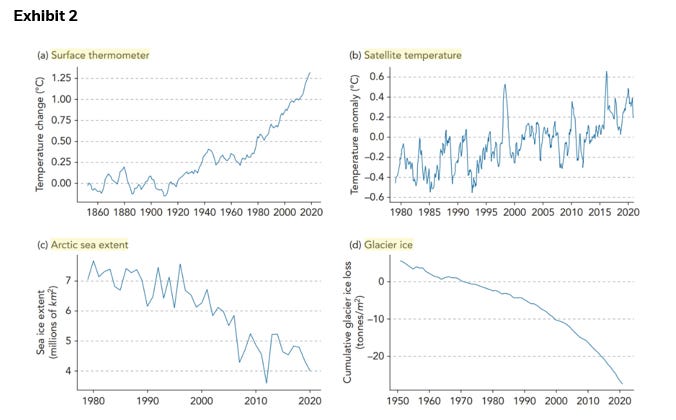Climate Science 101: What is Climate Change?

Hi All,
Today, I wanted to have a deep-dive into ‘climate change.’ I will not bore you with the obvious and the list of recent record-breaking heatwaves, wildfires, and hurricanes, which led to significant loss of life, property damage, and economic disruption. Still, please bear with me as I believe ‘collective wisdom’ is the only way to solve this enormous global issue - as Greta Thunberg noted, ‘the most important conclusions are yet to be drawn’ - it will be drawn by individuals like you and me once we fully understand the basic science of sustainability and climate science. So, here we go!
I. What is Climate Change?
A: Short Answer => Climate change = the long-term differences in the statistics of weather patterns measured over multi-decadal periods (minimum 30 years).
A: Long Answer => Climate change refers to the long-term alteration of global temperature and typical weather patterns caused by human activities, specifically the emission of greenhouse gases such as carbon dioxide and methane. These emissions trap heat in the atmosphere, leading to rising temperatures and a wide range of environmental and social impacts.
The issue of climate change is important to address because of its significant and far-reaching effects. Climate change poses a threat to human health and well-being, natural ecosystems, and global economic stability. The impacts of climate change are already being felt around the world, including extreme weather events like hurricanes, droughts, floods, and wildfires, as well as melting glaciers and sea level rise.

When we talk about climate, temperature is the most commonly referred to quantity, but there are many other quantities such as precipitation, humidity, cloudiness, visibility, and wind that tell the full climate change story. Because there is a lot of day-to-day and year-to-year variability in the weather, the climate is typically estimated from the statistics of the weather over a period of several decades, typically 30 years.
Below figures in Exhibit 2 show change in global average temperature since the late-nineteenth century, estimated from thermometers distributed across the planet. The surface thermometer record shows that the Earth has warmed by 1.1°C over this time (calculated as the difference between the 1850–1900 average and the 2009–2018 average). (Source: IPCC)
Exhibit 1 - The distribution of modern warming (in °C) – roughly at 1.1°C. Warming is calculated as the difference between the 1850–1900 average and the 2009–2018 period.



(a) Global annual average temperature (°C), relative to the 1850–1900 average; data have been smoothed to remove short-term variability. (b) Satellite measurements of the global monthly average temperature anomaly (°C), relative to the 1991–2020 period. (c) Arctic sea-ice extent (in millions of square kilometers) in September of each year. (d) Global average cumulative mass change of the world’s glaciers, tonnes/m2. (e) Ocean energy content (Joules) of the top 2000 m of the world ocean, relative to the 1979–1994 mean. (Boyer, Tim P.; Smolyar, Igor V., et al. [2018]. World Ocean Atlas 2018. NOAA National Centers for Environmental Information.) (f) Global-average sea level change, measured by satellite-borne instruments, in millimeters. The seasonal cycle has been removed.
Exhibit 3 - This NASA’s video shows how Arctic Sea ice has been changing between 1984 and 2016 (1:28)
Exhibit 4 – NASA | A Year in the Life of Earth’s CO2 (3:10) An ultra-high-resolution NASA computer model has given scientists a new look at how carbon dioxide in the atmosphere travels around the globe.
II. What Causes Climate Change – Energy Balance?
A: The source of energy for the Earth’s climate = sunlight.
Sunlight = visible radiation that provides about 340 W/m2 of energy to the Earth (that’s a global and annual average).
About 30% of this incoming sunlight is reflected back to space by clouds and other reflective elements of the climate system, meaning that net solar energy absorbed by the surface of the Earth is 238 W/m2. In the 1820s, Joseph Fourier recognized that this meant that the Earth had to also be radiating an equal amount of energy back to space. This radiation back to space is in the form of infrared radiation, but for this analysis consider it heat.


The amount of energy radiated by an object is determined by the temperature of the object—as the object heats up, it radiates more energy. This means that the amount of heat radiated by the Earth to space is determined by the temperature of the planet. So for a given amount of energy from the Sun, there is a temperature of the planet that will give you an equal amount of energy radiated back to space.
This is the most important rule of the Earth’s climate: energy balance. The energy reaching the Earth from the Sun must be equal to the energy the Earth radiates back to space, and this determines the temperature of the climate system.
III. Energy Balance & Green House Gases (GHS)
The Earth's energy balance is maintained by the greenhouse effect, which refers to the process by which certain gases in the Earth's atmosphere trap heat and prevent it from escaping into space. The main greenhouse gases are carbon dioxide (CO2), methane (CH4), water vapor (H2O), and nitrous oxide (N2O).
Human activities, such as the burning of fossil fuels, deforestation, and industrial processes, have significantly increased the levels of these greenhouse gases in the atmosphere, leading to an enhanced greenhouse effect and an imbalance in the Earth's energy budget.
As the concentration of greenhouse gases increases, more heat is trapped in the Earth's atmosphere, causing the planet to warm. This warming leads to a range of impacts, such as melting ice caps, rising sea levels, and more frequent and intense extreme weather events.
Moreover, the increased temperature of the planet also leads to feedback mechanisms that amplify the effects of greenhouse gas emissions. For example, as ice melts, less sunlight is reflected back into space, leading to further warming. Similarly, as permafrost thaws, it releases large amounts of methane, a potent greenhouse gas, into the atmosphere, further amplifying warming.
In summary, human activities have caused an imbalance in the Earth's energy budget by increasing the levels of greenhouse gases in the atmosphere, leading to an enhanced greenhouse effect and a warming planet. To address climate change, we must reduce greenhouse gas emissions and restore the Earth's energy balance.
Next time, we will discuss ‘greenhouse gases’ and why we focus on ‘carbon’ so much despite there are many other greenhouse gases.
IV. Additional Resources
- Intergovernmental Panel on Climate Change (IPCC) - The IPCC is the leading international body for the assessment of climate change. Their reports provide a comprehensive and authoritative overview of the science of climate change, including its causes, impacts, and potential solutions.
- NASA Global Climate Change - This website provides a wealth of information on climate change, including data on global temperature, sea level rise, and greenhouse gas emissions. It also includes educational resources, interactive tools, and multimedia content.
- MIT Climate Portal - Highly recommend the site if you want to understand the scientific aspect of climate change and also access 'climate knowledge for everyone' has an interactive and animated MIT Climate Primer and podcasts.
- Grantham Institute - The Grantham Institute at Imperial College London is a research institute focused on addressing some of the world's most pressing environmental issues, including climate change, air pollution, and food security.
- Yale Climate Connections - This website provides news and analysis on climate change from a variety of perspectives, including science, policy, and culture. It features articles, podcasts, and videos, and is a great resource for keeping up-to-date on the latest developments in climate science.
- TED Talks - TED features a variety of talks on climate change, ranging from scientific presentations to personal stories and solutions. Some talks you may find interesting include "The Most Terrifying Video You'll Ever See" by Dr. Greg Craven and "The Case for Optimism on Climate Change" by Al Gore.
- Journal of Climate - This peer-reviewed journal publishes original research articles on all aspects of climate science, including climate change, variability, and prediction. It is a great resource for academic research on the topic.
- Nature Climate Change - This peer-reviewed journal publishes research on the impacts of climate change, as well as potential solutions and mitigation strategies. It is another great resource for academic research on the topic.
- World Emissions Clock - The World Data Lab (WDL) launched the World Emissions Clock (WEC) on the margins of COP27 in Sharm-el-Sheikh. The WEC was funded by the Federal Ministry of Economic Cooperation and Development of Germany (BMZ), the German Agency for International Cooperation (GIZ) and the Patrick McGovern Foundation. It was also developed in partnership with the International Institute of Applied Systems Analysis, University of Oxford and the Vienna University of Economics and Business.
![Sustainable/Impact Investing] Regulations Cheatsheet - State of Play (December 2025)](/content/images/size/w720/2025/12/Screenshot-2025-12-08-073043.png)
![Obsidian Brief] When Money Becomes Software: AI, Stablecoins & Bitcoin — Implications for Sustainable and Impact Investing](/content/images/size/w720/2025/12/Gemini_Generated_Image_dppem0dppem0dppe.png)
![Sustainable/Impact Investing] Building for Planetary Renewal - Urban Sequoia (A lecture by Mina Hasman, Sustainability Director at SOM)](/content/images/size/w720/2025/10/Screenshot-2025-10-30-221501.png)